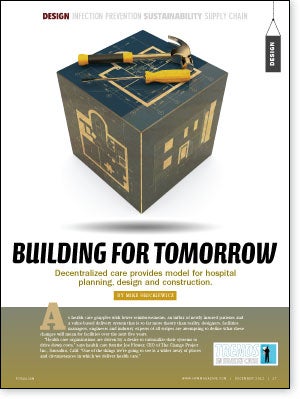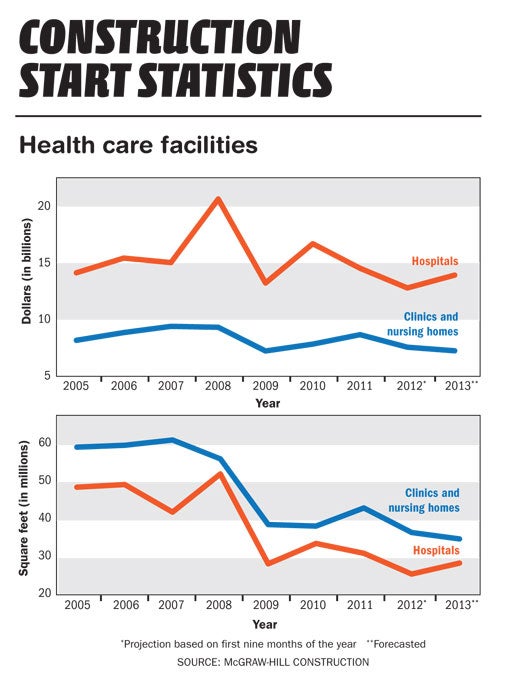Building for tomorrow
 As health care grapples with lower reimbursements, an influx of newly insured patients and a value-based delivery system that is so far more theory than reality, designers, facilities managers, engineers and industry experts of all stripes are attempting to define what these changes will mean for facilities over the next five years.
As health care grapples with lower reimbursements, an influx of newly insured patients and a value-based delivery system that is so far more theory than reality, designers, facilities managers, engineers and industry experts of all stripes are attempting to define what these changes will mean for facilities over the next five years.
"Health care organizations are driven by a desire to rationalize their systems to drive down costs," says health care futurist Joe Flower, CEO of The Change Project Inc., Sausalito, Calif. "One of the things we're going to see is a wider array of places and circumstances in which we deliver health care."
Community outreach
Most agree that key goals of health care organizations will include an increased emphasis on community health, treating routine cases away from the expensive, high-acuity environment of the traditional hospital through networks of ambulatory centers, physician practices, urgent care clinics and similar facilities.
These facilities will be established closer to the population, tied together through electronic health record (EHR) systems and constructed under business occupancy codes rather than more expensive institutional codes. They also will differ from many of their predecessors by featuring large spaces where cross-functional care teams can collaborate, says Flower, author of the book Healthcare Beyond Reform: Doing it Right for Half the Cost.
"I think most [organizations] are already positioning themselves from a planning standpoint to have satellite hospitals and clinics and primary care settings as feeders into the health system," says Joseph G. Sprague, FAIA, FACHA, FHFI, senior vice president and director of health facilities for architectural firm HKS Inc., Dallas, and president of the Facility Guidelines Institute, which publishes the Guidelines for Design and Construction of Health Care Facilities. "So, some of this is already designed in place and it will just continue to grow."
On the back end, such systems also may include senior care and rehabilitation facilities, as health care organizations seek to avoid the Affordable Care Act's readmission penalties. "Post-acute care services are going to be part of this health system, because you don't want to have the readmit issue come up," adds Sprague, who says the 2014 Guidelines will include a Part II that will concentrate on residential care.
Over time, Flower believes this emphasis on the continuum of care also will push fast-advancing home care and monitoring technologies. "We're going to see actual delivery through home health care and virtual care delivered through smart phone apps and virtual connections to customers."
Intense activities
As many of these low-acuity activities are shifted off-site, the main hospital likely will see increased intensity as it handles the sickest of the sick, experts say.
"Some of the things you're expecting are increasing acuity and, because of legislation and changes in insurance and reimbursement, probably a greater focus on the emergency department for a while," says D. Kirk Hamilton, FAIA, FACHA, EDAC, professor of architecture and associate director of the Center for Health Systems & Design at Texas A&M University, College Station. "It's plausible to say that the hospital proper will be shrinking around the critical care, emergency department, trauma facilities and the most exotic of the diagnostic technologies, and so the hospital of the future might very well be quite a bit smaller."
This, in turn, will test planning, design and construction professionals to design the hospital to operate as efficiently as possible, according to Anthony Roesch, AIA, vice president at the global architecture firm HOK Healthcare.
"In the past when we did facility planning, it was basically revenue-driven so they would build an addition to the hospital with a new service program with the purpose of driving new revenue and that revenue supported the capital investment," Roesch says. "But in today's market and the near future, hospitals really are going to be more the cost center than the revenue center in the scheme of an integrated health care delivery system."
Chief among these efficiencies are safety features to assist health care organizations with patient quality measures. "You're seeing Medicare withhold payments to systems because of readmissions or health care-associated infections or some sort of condition that should have or could have been avoided upon entrance into the system," Sprague says. "So, the challenge will be to plan and design everything to get it right the first time and then to operate it that way."
Flower, a board member for the Center for Health Design (CHD), believes evidence-based design strategies can help. He points to a study that CHD and various authors wrote for the Hastings Center Report, "Fable Hospital 2.0: The Business Case for Building Better Health Care Facilities," as proof that a financial case can be made to CEOs on the link between design and quality of care.
"The point of the study was to make a business case for designing in such a way that you reduce infections, reduce patient falls, shorten length of stay and reduce [the instances of] people having to be readmitted for various reasons," Flower says. "They were able to show that it would cost something like 10 percent more to build it according to the best evidence-based design, but you'd get payback on that extra 10 percent in just three years and then it would be less expensive over time."
Most experts agree that a certain degree of design standardization also can be economical. Given the growing importance of patient satisfaction measurements, it also will be important for designers to pay attention to consumer preferences, according to Sprague.
Flexibility is another key to efficiency, architects say. "When they're talking about flexibility these days, they mean increasing utilization of the space," says Roesch. "Hospitals can't afford to have a tremendous amount of downtime in various services, so flexibility comes in terms of changing scalability."
An adaptable design is often easier said than done, however. Problems often arise when administrators aren't specific about the kind of flexibility they want, Hamilton says. Standard accounting procedures that separate capital costs and operational costs also work against flexible designs by emphasizing first costs to the detriment of life-cycle savings, he adds.
Another challenge over the next five years will be how well designers can adapt existing structures to new uses. "Current assets are very important in terms of how well they can be repurposed or reused," says Roesch. "For various services, we used to always demolish the facility, but hospital administrators are now asking how we can repurpose them."

Beneath the surface
One intriguing example of a flexible facility offered by Hamilton is a hospital in Canada that has no interior columns and features interstitial space for utilities between each floor. While the front-end costs may give some administrators pause, over the past 25 years the hospital has saved by enabling it to change its occupancies without having to build out or even temporarily close any units.
In fact, many of the greatest opportunities for achieving efficiencies center on facilities infrastructure. "The hospitals that survive over the next five years must have a lower cost of operation," says Clay Seckman, executive vice president and director of the health care program for the engineering firm Smith Seckman Reid Inc., Nashville, Tenn. "And that's everything from utilities to staffing to operation and maintenance procedures."
Energy, in particular, is a closely watched variable. "Twenty years ago, we made decisions based on other things and energy was whatever it was," Seckman says. "Now, when we go into the conceptual stage of a project, one of the first questions asked is: What is our energy use intensity, what target are we going to hit and what decisions are we going to make to hit that target?"
This likely will lead to more innovative energy-saving strategies, such as a current hospital project in which Seckman's firm installed a geothermal heat pump system that uses some 300 250-foot bore wells.
It also will lead to more advanced building control systems, especially as already-stretched operations-and-maintenance staff find themselves monitoring the energy and performance of far-flung networks of hospitals, ambulatory care centers, physician clinics and other less easily defined facilities.
Information technology infrastructure will be another area of emphasis over the next five years.
"The Accountable Care Act put into place federal mandates for EHR which has created the need for the infrastructure and data center upgrades health care facilities are facing now," says Ted Hood, senior vice president and COO for health care technology consulting firm GBA, Franklin, Tenn. "We see that continuing steadily as more facilities try to adopt the federally mandated requirements for meaningful use and medical equipment interoperability."
Ultimately, Hood sees the main hospital as a central hub for information flowing throughout a health care organization and its satellite facilities.
Thoughtful response
"Health care facilities are going to change and evolve as the management of patient care goes across a broader spectrum and moves away from episodic care within the hospital," says Roesch, summing up the challenges ahead. "Hospitals, in turn, are becoming an information industry rather than simply a health care delivery industry."
"We have no idea how health reform will ultimately end up," adds Sprague. "But I think it's probably on the right track and those of us in the design and facilities management areas will need to respond to industry forces in a thoughtful and dedicated way."
Mike Hrickiewicz is editor of Health Facilities Management.




